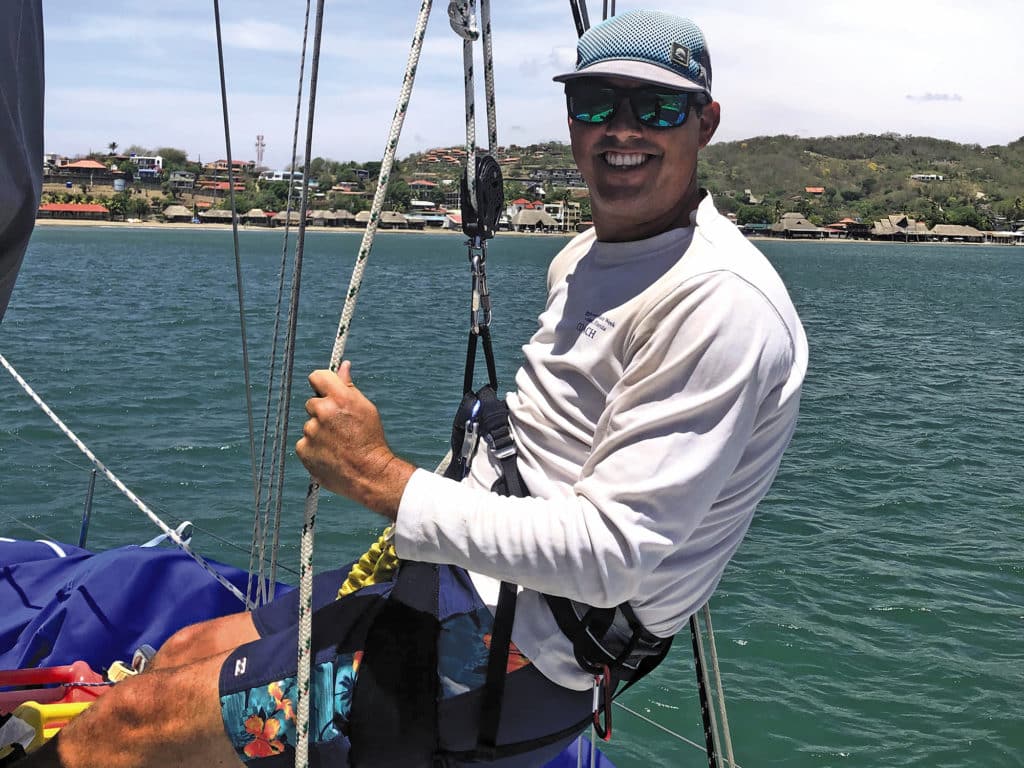
Lounging in the cockpit, my wife, Jill, and I chat about the days ahead while the autopilot diligently steers Yahtzee, our Grand Soleil 39, southward down the sunny Pacific coast of Nicaragua. Sailing under a full main and our code zero headsail in 12 to 15 knots of warm breeze, it’s one of those perfect days that cruising dreams are made of, until…pop! Almost like a gunshot, the spinnaker halyard block at the top of the mast explodes, and the big sail lurches down and forward, luffing wildly behind the mainsail.
Scurrying to the foredeck, I can see that the spinnaker halyard is dangling out of where it exits the mast, some 3 or 4 feet below where the now-shattered block had been attached. Together, we quickly attempt to furl the sail, and I work to wrangle it while it whips from side to side in the rolling seas. Not good.
Now, to get it down.
I stand by on the foredeck to gather the code zero to the deck as Jill lowers the halyard, but when she eases it off the winch…nothing happens. Well, damn. I look aloft and see that the halyard is stuck where it exits the mast. It won’t budge, and with nightfall approaching and 100 miles to go to our destination, we can’t leave it thrashing around. Also, it’s very likely that the halyard will soon chafe through and, when it does, the sail will fall into the ocean.
There is only one solution: I’m going up the mast.
Still underway and sailing at about 4 to 5 knots under main alone, Yahtzee rolls with the seas while I rig my climbing apparatus and harness. Going aloft up a sailboat’s rig needs to be done with care and caution anytime, but particularly while at sea and many miles from potential help. Accordingly, I check and double-check the hoisting halyard and safety halyard. I adjust and readjust my harness and give the system’s locking shackles an extra-firm turn. And we send a satellite message to a buddy boat ahead of us letting them know what’s going on.
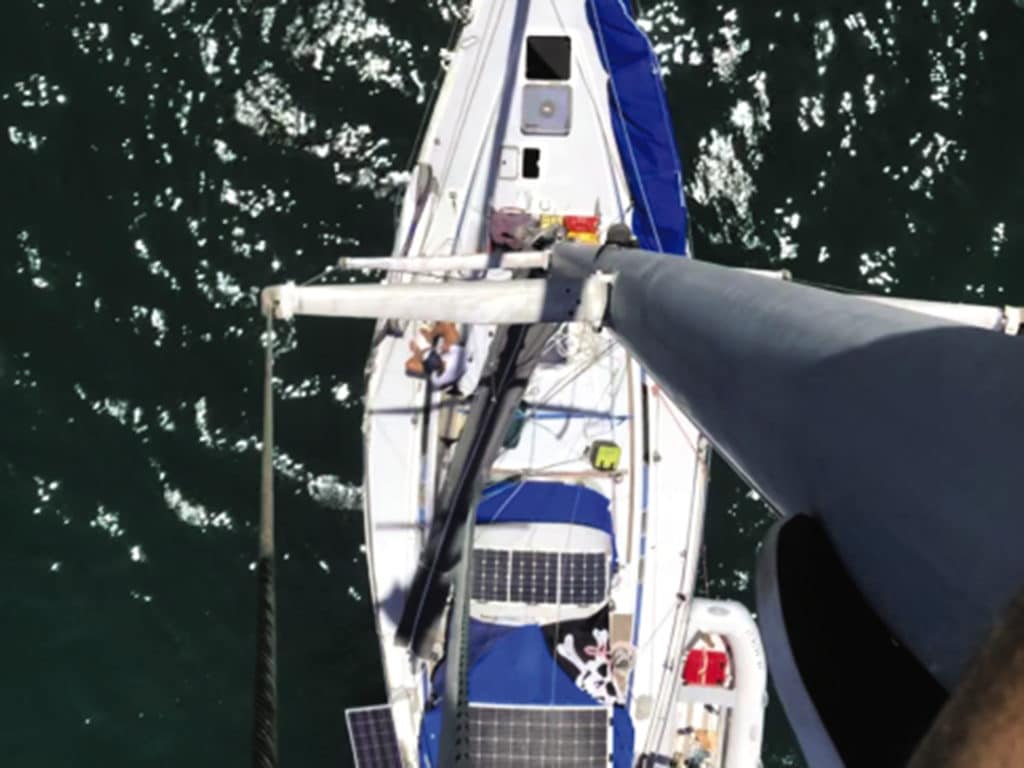
Having gone aloft at sea before, I know that the heaving motion at deck level is going to get progressively worse the higher up I go, and I make sure to have a safety tether to wrap around the mast and secure myself when needed. Lastly, I tie a length of line to my harness that I can use to lower the sail down once I’m able to release it from the stuck halyard. Go time.
With Jill standing at the base of the mast helping me ascend, I start the climb, holding and pulling on the hoisting line with one hand and bracing myself against the mast with my other hand and my legs. The going is slow, and I have to stop every few feet to hold on as the boat rolls. When I feel a lull, I keep moving. Plodding ever upward, I make it over the first set of spreaders and take a rest to catch my breath. Looking around, the ocean is beautifully blue, and it’s a breathtaking sight to watch Yahtzee move gracefully over the water. But I have to keep moving.
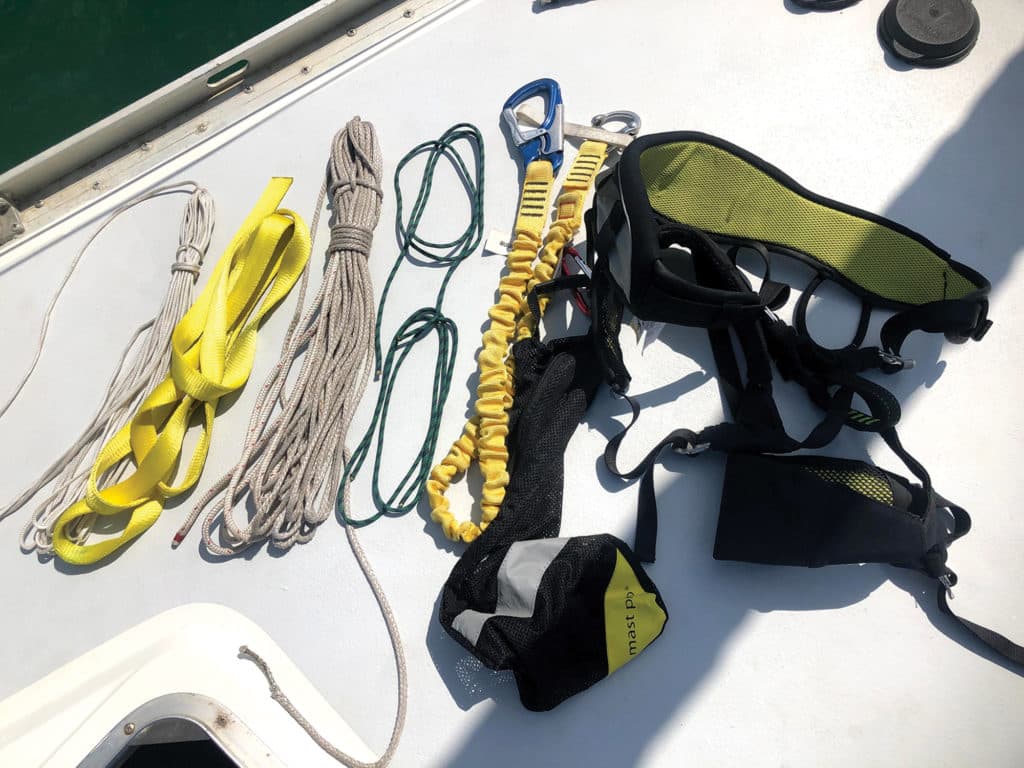
From the first set of spreaders, I look upward and begin the climb anew. Finally, I make it over the second set of spreaders, stand up, secure my safety tether around the mast in front of me, and lean back into it. Again, I need to rest before I can start to work on the sail. While I pause, I think about all the solo ocean racers who make this climb with no assistance while sailing much faster and in far worse conditions—my hat goes off to them.
Finally, it’s time to get to work. With the top of the code zero swinging at head height, I take the line from my harness and wait for another lull in the rolling. Holding the mast with my left hand, I reach out with my right, put the end of the line through the top shackle of the sail’s furler, and tie a one-handed bowline as the sail swings in wild circles, forward and back, toward me and then away. The exertion of doing this is tremendous, and I have to compose myself again before opening the halyard shackle and lowering the sail down to Jill on deck.
With the line secure, I make another bowline in the other end and slip it over a fitting on the mast. I don’t want the furled sail to come crashing down when the halyard is released. Ready now, I take up as much extra line as possible, and hold it and the mast in my left hand. Then, I reach out and pop open the snap shackle with my right.
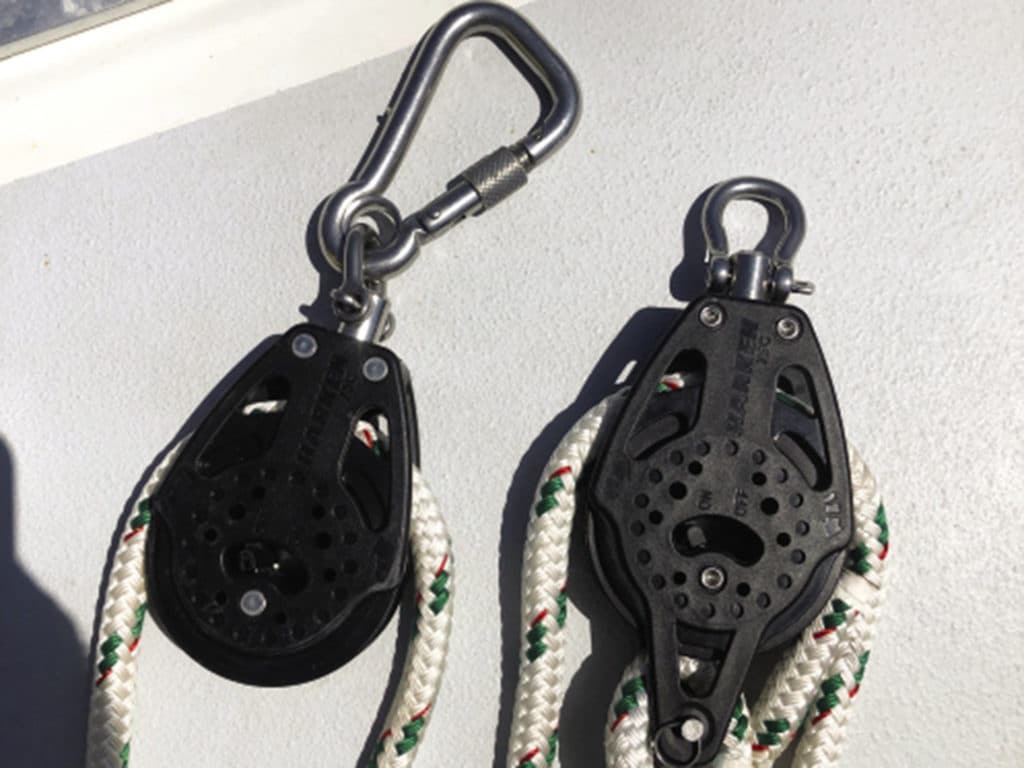
As expected, the sail drops a couple of feet hard and fast, and my left hand grips tight so as not to let it get out of control. With the sudden release and violent pull from the freed sail, I instantly feel a shocking pain in my left hand and look to see blood in my palm, on the mast, and covering a split-open pinkie finger. Wincing in pain, I can’t let go of the line. Due to the pressure, my left hand is stuck against the mast, and I grab the head of the sail with my right hand to lift it up and provide some slack. It works, and with my hand free, I’m able to lower the sail down.
Relieved, I assess the damage to my split-open finger, wipe the blood off the mast and my hand onto my shorts, and get ready for the descent. I know this part is just as difficult and dangerous, if not more so, than going up. The way my climbing rig is set up, I can lower myself, but I have to do it with one hand—in this case, my left. Wrapping my feet around the mast, I inch my way down, stopping at points when the boat is rolling too much and to rest. Sweat drips down from my hat, under my sunglasses and into my eyes, but with every foot I descend, I can feel the freedom from this harness and mast.
At the first spreader, I stop and look out again for one last aerial glimpse of the ocean and of the wake Yahtzee leaves astern. All of this, I think, is part of life on a sailboat at sea.
When my bare feet finally meet the warm deck, my body is shaking: vibrating both with exhaustion and the feeling of success. Jill pushes a cold cup of water into my hand, and it goes down, seemingly, in one giant gulp. About two hours after hearing that fateful “pop,” the code zero is once again hoisted and set, and full of breeze again. Yahtzee is bounding south, with the sun dropping toward the horizon. Jill and I are back in the cockpit enjoying the evening, and the only thing that’s worse for wear is my throbbing pinkie finger. I’ll take it.
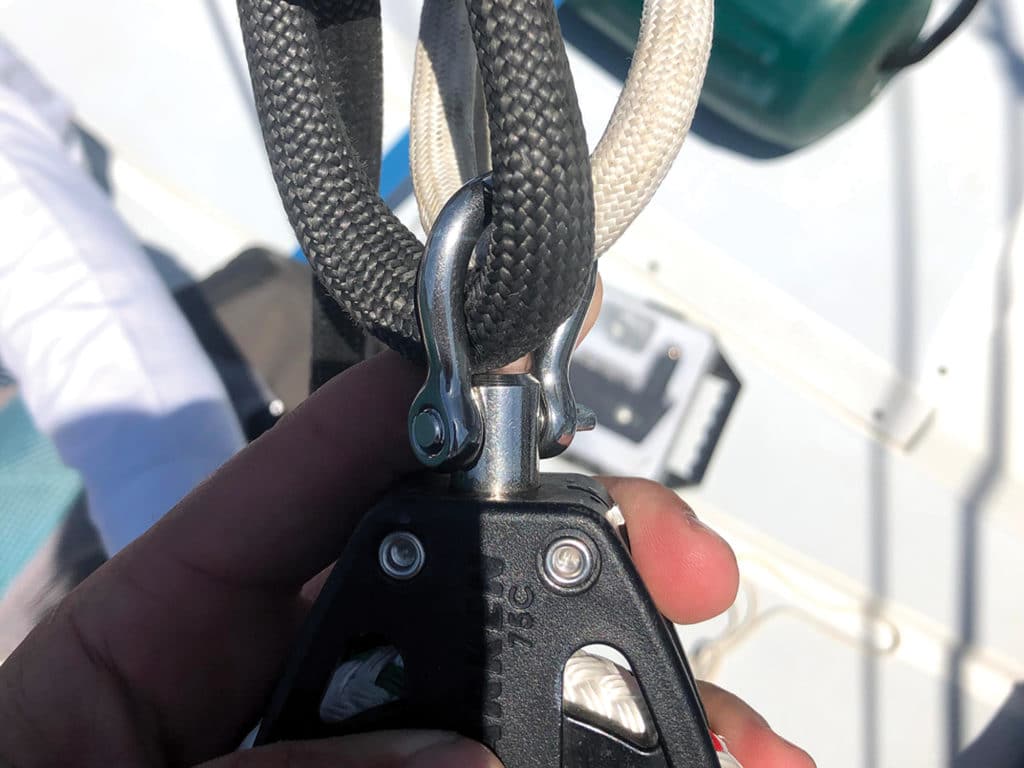
The question everyone asks when I relate this tale to fellow sailors is always the same: What “apparatus” do you use to go aloft? Before going into any great detail, I always start by saying that there are numerous ways to go up a mast, and as long as you do it safely, that’s all that matters. My particular setup and method was taught to me and honed while working as a rigger’s assistant for several years and, having ascended many masts since, I’ve dialed in my gear and technique to go aloft safely and efficiently in almost all conditions.
Simply put, I use a block-and-tackle system that allows me to pull myself up and let myself down without help, or need for grinding winches, or trusting someone else to ease me down. Here’s a look at my climbing rig and how I set it up and use it.
When it comes to the gear, I’m a fan of a rock-climbing-style harness instead of a bosun’s chair because it’s what I feel most comfortable and secure using. My home-built hoisting setup is fairly straightforward and includes a Spinlock Mast Pro harness, a swiveling 75 mm Harken Carbo Ratchet block that gets attached to my harness, a swiveling 75 mm Harken Carbo Ratchet becket block that attaches to the halyards, and 200 feet of 7/16 double-braid line that gets run in between. On the top block, I replaced the original shackle with a stainless-steel Wichard bow shackle with a self-locking pin. To connect the bottom block to my harness, I use a standard Wichard self-locking shackle and a stainless-steel twist-locking carabiner that can be operated with one hand.
When first setting up the system, I tie a bowline to the becket of the top block and secure the tail with a zip tie. The line then runs down to the bottom block and up over the top block. To hoist the rig up the mast, I attach a main halyard, and a spare halyard as a safety (both with Dyneema chafe guard spliced on), and pull the top block to a desired position on the mast, typically all the way up. What I’m left with is a long section of working line hanging from the top block that I use to pull myself up or ease myself down one-handed.
The key to safely using this system is that both blocks are ratcheting. With the blocks set in the ratchet position, they will spin and click when I pull myself up, but when I let go, they don’t spin, and because of the friction placed on the line, it stops moving. I can literally let go of the line and I won’t fall. That said, when I get to where I want to work, I tie two half hitches with the working line above the bottom block as a safety, and also secure myself to the mast with a safety tether. Then, when I want to move down to a different spot on the mast or to deck level, I simply switch off the ratchet on the bottom block only and then ease down in a controlled manner.
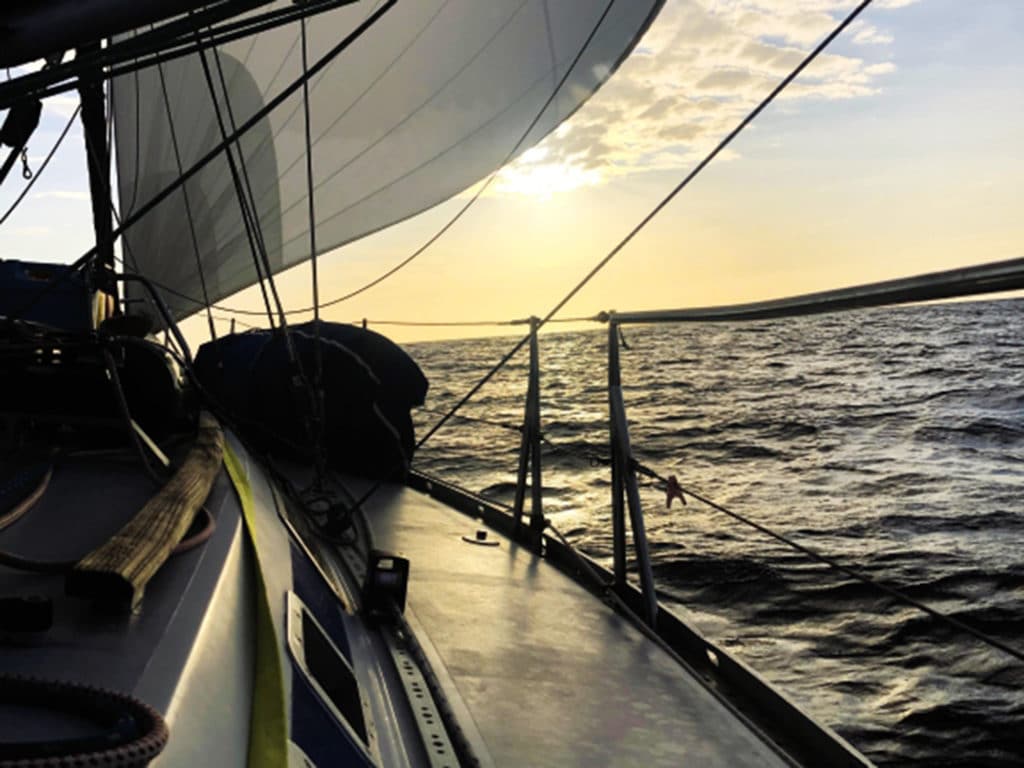
To make going up less strenuous (and down one check safer), Jill can, and often does, help pull from deck level to help me up (and she can tail the line when I’m coming down). If I start descending too fast (which has never happened), she can just hold the line fast and I will stop instantly. When I’m back on deck, I simply lower the whole system down into a bag, flaking it from the bottom to the top. Done and dusted.
If you choose to go with a similar system, you’ll need to know how high your masthead is from deck level so you can purchase the proper amount of line. Once you’re set up, I suggest practicing the up-and-down part several times without going much higher than the gooseneck. Have a partner or another crewmember there to assist and, if they’re comfortable, let them try it so they know how the system works too. When you’re confident operating your new climbing rig, keep going up!
After seven years cruising and living aboard their Grand Soleil 39, Yahtzee, in the Pacific Northwest and Alaska, Andy, his wife, Jill, and their two young sons sailed south for warmer waters, and have been exploring Mexico and Central America since 2019. You can follow their adventures at sailingyahtzee.com.








